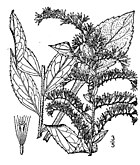
Solidago canadensis, known as Canada goldenrod or Canadian goldenrod, is an herbaceous perennial plant of the family Asteraceae. It is native to northeastern and north-central North America and often forms colonies of upright growing plants, with many small yellow flowers in a branching inflorescence held above the foliage. It is an invasive plant in other parts of the continent and several areas worldwide, including Europe and Asia. It is grown as an ornamental in flower gardens.

Solidago flexicaulis, the broadleaved goldenrod, or zigzag goldenrod, is a North American species of herbaceous perennial plants in the family Asteraceae. It is native to the eastern and central parts of the United States and Canada, from Nova Scotia west to Ontario and the Dakotas, and south as far as Alabama and Louisiana. It grows in a variety of habitats including mesic upland forests, well drained floodplain forests, seepage swamp hummocks, and rocky woodlands.

Solidago juncea, the early goldenrod, plume golden-rod, or yellow top, is a North American species of herbaceous perennial plants of the family Asteraceae native to eastern and central Canada and eastern and central United States. It grows from Nova Scotia west to Manitoba and Minnesota south as far as northern Georgia and northern Arkansas, with a few isolated populations in Louisiana and Oklahoma.

Solidago sempervirens, the seaside goldenrod or salt-marsh goldenrod, is a plant species in the genus Solidago of the family Asteraceae. It is native to eastern North America and parts of the Caribbean. It is an introduced species in the Great Lakes region. Similar plants found in the Azores are thought have evolved from a natural introduction of this species.

Solidago caesia, commonly named blue-stemmed goldenrod, wreath goldenrod, or woodland goldenrod, is a flowering plant native to North America.

Solidago nemoralis is a species of flowering plant in the family Asteraceae. It is native to North America, where it is widely found in Canada and the United States. Its common names include gray goldenrod, gray-stem goldenrod, old-field goldenrod, field goldenrod, prairie goldenrod, dwarf goldenrod, and dyersweed goldenrod.

Solidago altissima, the tall goldenrod or late goldenrod, is a North American species of goldenrod in the family Asteraceae which is widespread across much of Canada, the United States, and northern Mexico. It is common in much of its range and fairly tolerant of landscapes which have been disturbed by humans. It has become naturalized in many parts of the world.

Solidago gigantea is a North American plant species in the family Asteraceae. Its common names include tall goldenrod and giant goldenrod, among others.

Solidago odora, the sweet goldenrod, anisescented goldenrod or fragrant goldenrod, is a North American species of goldenrod within the family Asteraceae. The plant is native to the United States and Mexico, found in every coastal state from Veracruz to New Hampshire and as far inland as Ohio, Missouri, and Oklahoma. It flowers from July through October.

Solidago velutina, the threenerve goldenrod or velvety goldenrod, is a plant species native to Mexico and to the western United States. The species has been found in southwestern Oregon, east to the Black Hills of South Dakota, and as far south as México State in the central part of the Republic of México. It is classified as a member of Subsection Nemorales.
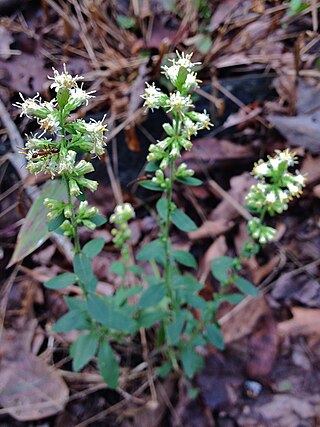
Solidago bicolor, with several common names including white goldenrod and silverrod, is a plant species native to much of eastern North America. It is found in Canada and in the United States. It prefers sandy and rocky soils, and can frequently be found along roadsides.
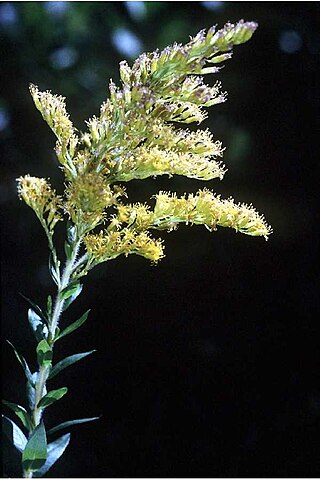
Solidago fistulosa, the pine barren goldenrod, is a plant species native to low-lying coastal areas of eastern North America. It grows in every state bordering on the Gulf of Mexico or on the Atlantic Ocean from Louisiana to New Jersey. It is generally found in bogs, along the edges of marshes, in drainage ditches, etc.
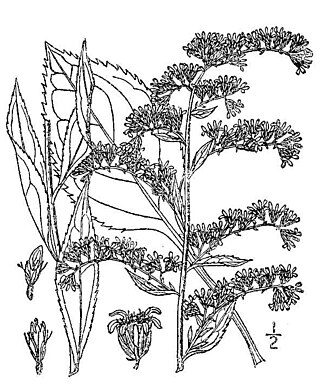
Solidago arguta, commonly called Atlantic goldenrod, cut-leaf goldenrod, and sharp-leaved goldenrod, is a species of flowering plant native to eastern and central North America. It grows along the Gulf and Atlantic states of the United States from Texas to Maine, inland as far as Ontario, Illinois, and Kansas. It is primarily found in areas of woodland openings, such as outcrops or clearings.

Solidago rigida, known by the common names stiff goldenrod and stiff-leaved goldenrod, is a North American plant species in the family Asteraceae. It has a widespread distribution in Canada and the United States, where it is found primarily east of the Rocky Mountains. It is typically found in open, dry areas associated with calcareous or sandy soil. Habitats include prairies, savannas, and glades.

Solidago curtisii, commonly called Curtis' goldenrod and mountain decumbent goldenrod, is a North American species of flowering plants in the family Asteraceae. It is the eastern part of the United States from Pennsylvania to Mississippi and Alabama, primarily in the southern Appalachian Mountains.

Solidago erecta is a species of goldenrod known by the common names showy goldenrod and slender goldenrod. It is native to the eastern United States, from Massachusetts west to Indiana, and south as far as Georgia and Mississippi.

Solidago latissimifolia, common name Elliott's goldenrod, is North American species of flowering plants in the family Asteraceae. It is native to the Atlantic Coast of the United States and Canada, from Nova Scotia south to Alabama and Florida.
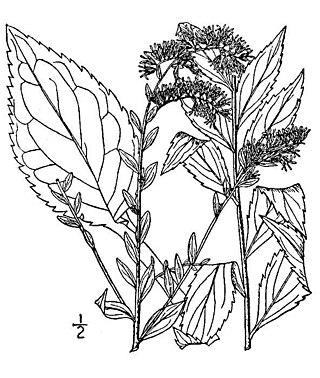
Solidago ulmifolia, commonly known as elmleaf goldenrod, is a North American species of goldenrod in the family Asteraceae. It is found in Canada and the eastern and central United States.

The goldenrod gall fly, also known as the goldenrod ball gallmaker, is a species of fly native to North America. The species is best known for the characteristic galls it forms on several species in the Solidago, or goldenrod, genus. The fly's eggs are inserted near the developing buds of the plant. After hatching, the larvae migrate to an area below the plant's developing buds, where they then induce the plant's tissues to form into the hardened, bulbous chamber referred to as a gall. E. solidaginis’s interactions with its host plant(s) and insect, as well as avian, predators have made it the centerpiece of much ecological and evolutionary biology research, and its tolerance of freezing temperatures has inspired studies into the anti-freeze properties of its biochemistry.

